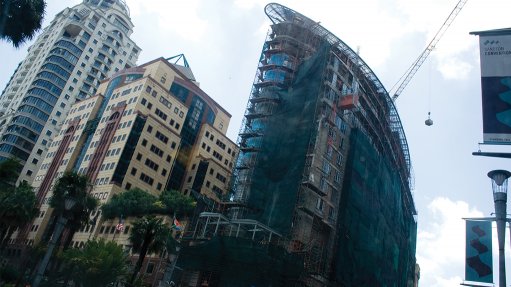
CONSTRUCTIVE BUILDING
Implementing a sustainable building philosophy provides value-add throughout the value chain
Photo by: Creamer Media
There is a direct link between the stability of an economy and ongoing development, says consulting engineers firm WSP Africa structures regional director Johan Piekaar.
Currently, the local construction and property industries are experiencing a lull owing to reduced expenditure by government on large scale infrastructure projects, as well as uncertainty in the private sector investment markets.
Findings in a survey from market analytics firmTimetrichighlight that growth in the local industry forecasted between 2017 and 2021 is expected to be more moderate than the review period of 2012 to 2016. However, Piekaar believes there is room for optimism.
He says despite the current economic climate, which is linked to fluctuations in global markets and further exacerbated by policy changes and political uncertainty locally, there remain domestic and international investors and developers who continue to forge ahead with projects across South Africa, as they see the great potential and value in the country.
Moreover, building for sustainability has become the main driver for most investors and developers, Piekaar says.
“We expect this trend to continue well into the future as government, businesses and citizens – who are the primarily targeted tenants of industrial and commercial spaces – grow increasingly socially conscious to the importance of resilience and the need to safeguard and manage critical resources in a more sustainable fashion.”
For example, each time South Africa has intermittently experienced load-shedding since 2008, social awareness on the importance of secure power increases. This sparks interest among developers to investigate solar-powered rooftop or on-site solutions that could self-power their buildings in the event of grid power interruptions.
Likewise, water shortages and consequent water restrictions that many areas across the country have faced in the past two years have created a sense of urgency among users to look into more efficient water management solutions. This has also opened up opportunities to capture and use rainwater, or to safely recycle and reuse grey water, to meet essential operational and living needs.
Piekaar says this rising social consciousness, coupled with continuous and growing pressure being placed on the “built space” to address inadequate energy resources, carbon reduction targets and tightening building energy efficiency standards, continues to drive sustainable building trends in South Africa.
“Building for sustainability and climate change mitigation has become integral in the design and construction of buildings in the country,” he notes.
The philosophy of building for sustainability is being led byresponsible engineering, which Piekaar describes as “doing what we can without costing too much, and showing return on investment value”.
It is also being led byresponsible building, which he says translates to driving the philosophy through the value chain.
“While previously it was thought to be more expensive to make the upfront capital investments to go green, volatility in both the cost and availability of power and water resource, for example, is influencing a mindset change,” Piekaar notes.
In addition, the whole lifecycle design of a building, including architects, consulting engineers and sustainability consultant teams, is being influenced through alternative and environmentally suitable building designs to offset the impact of the building on its immediate environment.
Therefore, Piekaar believes that, in the long-term, sustainable building design adoptions are financially beneficial owing to reduced energy consumption. Moreover, the use of renewable and more sustainable energy resources also has the propensity to reduce the carbon emissions associated with these buildings and provide increased resilience amid uncertain service delivery.
“These are all significant value-adds for customers and tenants, and what benefits the customers also benefits the developers and owners,” he says.
He adds that savvy customers realise the benefits of being more “green” and offsetting as much of their energy and water consumption as possible to take advantage of the many benefits that accrue from doing so.
“The rising social consciousness agenda is having a significant influence on the economic case for developments to be built for sustainability, which can assist in increasing their marketability,” Piekaar says.
He notes that it is key for investors, developers and their consultants and contractors to aspire to incorporate“climate responsiveness”and“designing within constraint”concepts when developing buildings.
“This will ensure that these buildings remain resilient and sustainable in an unpredictable future context,” he concludes.